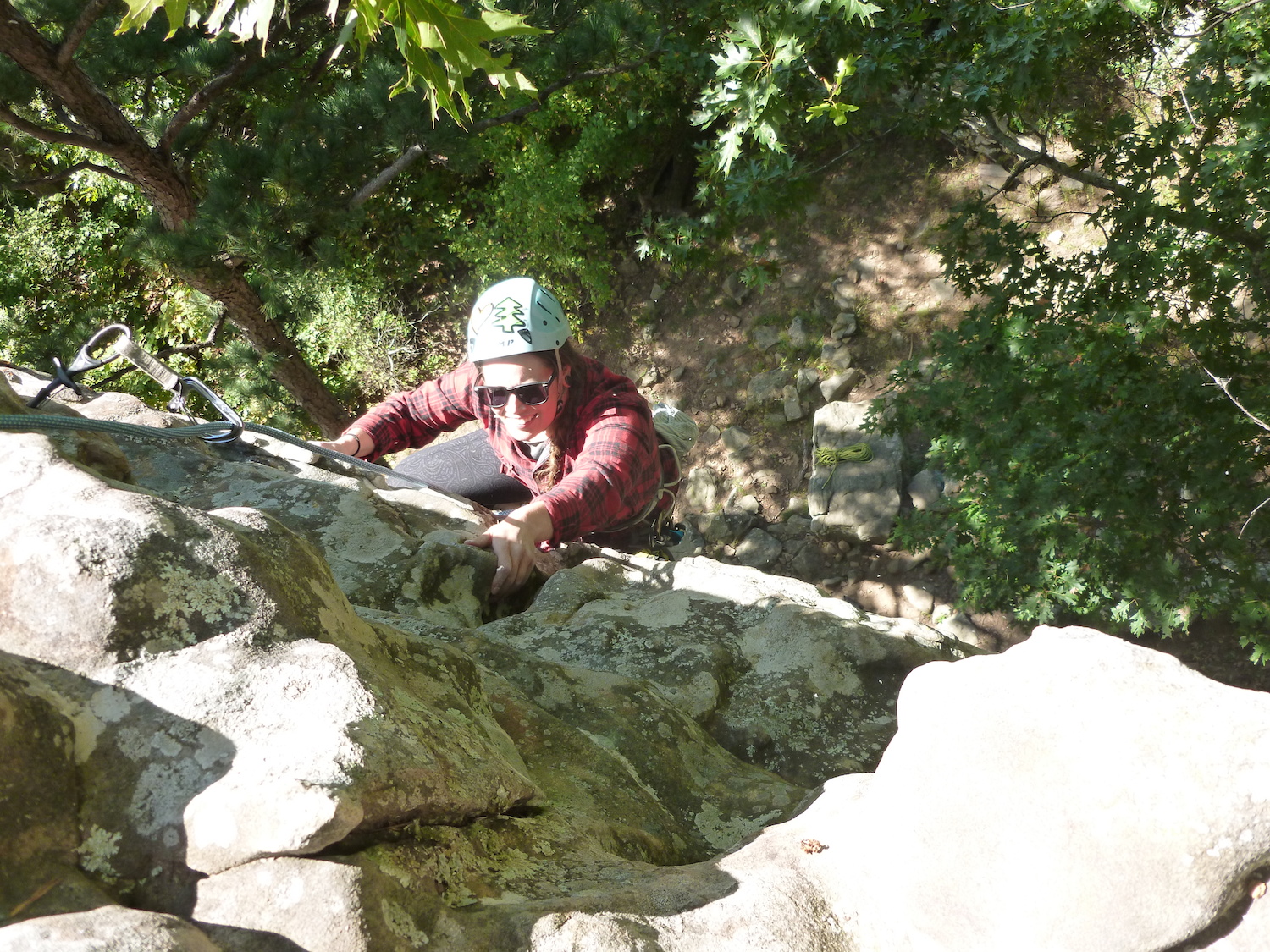I could’ve been spending the sunny, 65-degree Saturday calmly sipping a pumpkin-spiced latte before putting on my knee-high boots and cable-knit fall sweater to head to Eckert’s with the rest of St. Louis. Instead, I was sweating profusely, 20 feet up in the air, trying to figure out which size “cam” would fit into the rock wall to keep me from falling to my death.
“Falling to my death” is a bit of an exaggeration. I was safely tied into a top rope with my instructor, Jon Richard of Vertical Voyages, a mere foot away, calmly telling me to breathe, reassess and reposition my body so I had a more solid stance to solve the problem in front of me.
Still, nobody likes to fall off a rock wall.
I was learning how to “trad climb,” or traditionally climb — you know, how they used to do it in the days before “fall” meant that an orange squash plant flavored everything from my Oreos to my beer for three months of the year.
Traditional climbing allows you to climb virtually anywhere that has a line of corners and cracks to work with. You bring your own “protection” — a series of hexes, nuts and different sizes of spring-loaded camming devices — which you fit into the rock. It’s like an adult version of the wooden brainteaser puzzles you played as a child, except with slightly higher stakes.
As you ascend, you place these pieces of protection into the wall, clip in your rope and continue climbing. When you fall, the (correctly placed) gear will arrest your descent and save your bacon. Once you’ve finished climbing, you remove the pieces of gear and no one is wiser that you just scaled that awesome rock wall.
Mental Challenge
Trad climbing is in contrast to “sport climbing,” which began in the 1980s when people began drilling permanent protection, called bolts, into the rock face. Sport climbing is now the overwhelming popular choice, especially with beginner climbers, because it allows you to focus on the physical challenges of the climb without the mental or route-finding challenges that trad climbing offers.
But, then again, you lose the mental or route-finding challenges that trad climbing offers.
My journey to this point is a common story. It began by top-roping in the gym, after which some crazy person convinced me to take a lead climbing class. Then, “Oh, hey, let’s go outside and climb real rocks.” Spoiler alert: I loved it.
Subsequently inspired by magnificent climbing photos, possibly found on Pinterest, I decided I wanted to learn how to “multi-pitch” climb — basically, how to climb really high walls found in places such as Yosemite National Park.
The problem is, there are limited numbers of multi-pitch sport routes available and they’re often crowded. Richard suggested I might be interested in learning to trad climb, which would give me long-term skills and, ultimately, more freedom in the routes I’d be able to climb. I agreed.
So, that’s how I found myself in Sam’s Throne, Arkansas, at one of Richard’s two-day “Introduction to Trad Climbing” classes.
The Fall Guy
Richard’s emphasis throughout the class was enabling us to “do” rather than just learn the theory, or what he called “ground school” — where you learn to place gear without actually climbing on ropes. Instead, we built anchors, placed our own protection as we climbed, and, perhaps most importantly, took falls on the gear we had placed.
I was lead belaying my partner as she placed her second piece of gear. Richard stressed that we need to learn how and when to trust our gear to catch real falls. So, Sarah found a tiny purple cam, placed it in the rock, gave a tug or two and, quite confidently, climbed a little higher and let go for her practice fall.
I readied my stance, prepared to feel her weight the cam. Instead, I felt nothing but air. I watched — slightly horrified — as she continued to fall, pulling out the tiny cam as if it were mere decoration. I not-so-gracefully took some steps backward in surprise, only to fall off the rock ledge and land on my behind.
Fortunately, Sarah was safely tied into a top-rope, belayed by an instructor, completely safe in the hands of someone more experienced than me. After dusting off my pants (and pride), I checked in with Sarah, who wore a look of shock and excitement. Smiling, she raised her arm, placed her feet and began climbing again.
Bomber, dude.
Author: Kimberley Donoghue is a regular contributor to Terrain magazine.
Photo by: Kimberley Donoghue


Leave A Comment